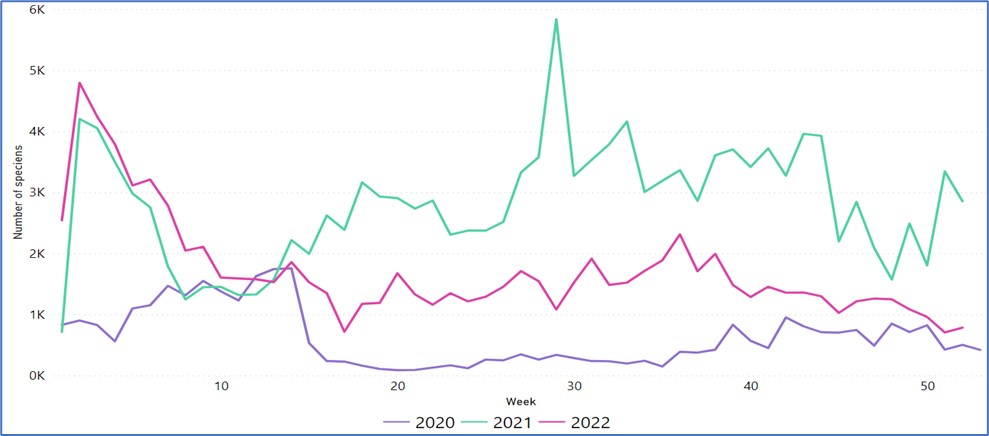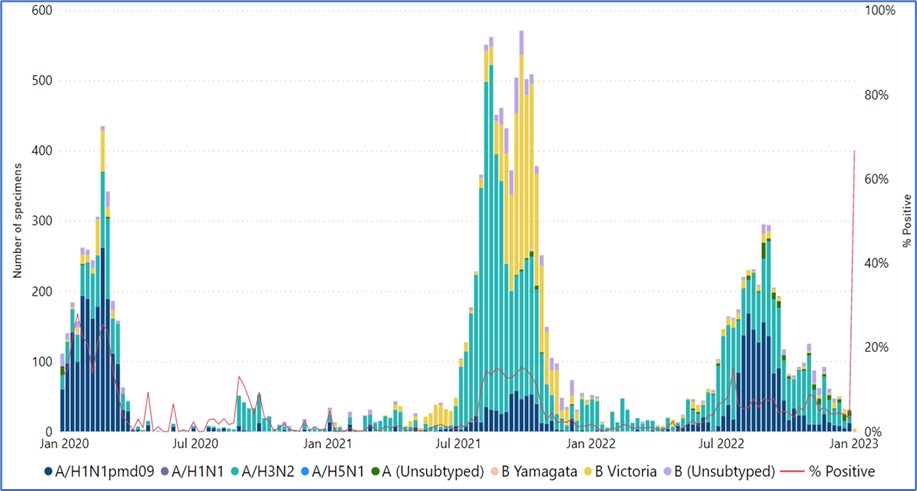Pandemic influenza preparedness
In 2022, Member States in the Region continued implementation of the WHO Global Influenza Strategy (2019–2030) approved by the 73rd World Health Assembly. These efforts promoted coordinated synergies between influenza preparedness and response capacity-building in alignment with the International Health Regulations (2005). The anticipated targets were achieving two high-level outcomes as outlined in the global strategy: (1) ensuring availability of better global tools for prevention, detection, control and treatment of influenza and (2) building stronger country capacities through an evidence-based influenza programme established on the principle of universal coverage that meets national health security needs.
These efforts were supplemented by provisions of the Pandemic Influenza Preparedness (PIP) Framework. The WHE in the Regional Office supported six priority Member States through country specific work plans of PIP Partnership (PC) Contributions for improving pandemic influenza preparedness and response while others are being supported through the WHO headquarters and regional office’s work plans of PIP -PC as per their needs.
WHE prioritized “Surveillance, monitoring and data utilization”, taking into account the prioritization of the COVID-19 response, stakeholders from Member States met virtually in April 2022 at a regional consultation to explore how best to sustain and further develop coordinated and integrated surveillance and other supplementary supporting systems for monitoring respiratory pathogens in the region. Participants determined regional high-priority objectives, strategies, needs and next steps for establishing sustainable surveillance for influenza, SARS-CoV-2, and other respiratory pathogens of epidemic or pandemic potential.
To provide policy and strategic guidance and better streamline these upstream global strategy implementation activities operationally at the country level, the WHO regional office collaborated with the WHO Regional Office for the Western Pacific to conduct the “Fifteenth Bi-regional Meeting of National Influenza Centers (NIC) and Influenza Surveillance in the Western Pacific and South-East Asia Regions” on 29-31 August 2022. The meeting focused on (1) identifying progress and challenges of implementing the global influenza strategy, noting potential implications for enhancing pandemic preparedness capacities, (2) understanding how best to strengthen existing sentinel surveillance and laboratory systems and leverage new approaches to increase early detection of novel influenza and other respiratory pathogens, and (3) discussing how best to implement sustainable surveillance systems for seasonal, zoonotic and pandemic influenza and other epidemic respiratory diseases in both regions.
To accomplish the strategic objective “Pandemic preparedness and response” in the Global Influenza strategy, stakeholders in pandemic influenza preparedness (PIP) from the South-East Asia Region came together in New Delhi in October 2022 to share experiences, discuss implementation challenges of PIP PC contributions and agree on priorities for action on 2023. During the meeting, the independent global PIP Framework Advisory Group representatives engaged with stakeholders to better understand regional perspectives and help bridge global PIP policies with regional implementation.
Despite multiple efforts of Member States, WHO Collaborating Centers and other partners in “Surveillance, monitoring and data utilization”, the number of specimens processed for testing for influenza in 2022 (88691) was 40% lower than the number processed in 2021 (146 444). However, that number of samples processed was higher than the recommended annual number of specimens across the region (85800) based on the threshold of 150 samples per NIC per week as recommended in the “WHO End-to-end integration of SARS-CoV-2 and influenza sentinel surveillance: revised interim guidance”. The trend of samples processed for testing for influenza (and also simultaneously for SARS-CoV-2) with multiplex real-time reverse transcription polymerase chain reaction (rt-PCR) assays for the period from 2020 to 2022 is illustrated in figure 1.

Figure 1: Number of specimens processed for testing for Influenza by weeks and years in WHO South-East Asia Region, 2020-2022. Courtesy: WHO
To guide Member States in their efforts to reduce seasonal influenza burden, the Regional Office continued to analyze the transmission patterns and characteristics of circulating seasonal influenza types and sub types. Though the seasonal influenza transmission pattern varied from country to country and even within geographical regions in big countries, the “Influenza test positivity percentage” demonstrated an increasing trend from early June (2%) and ultimately peaked in July (15%). The indicator continued to be high (15%-9%) through November and then gradually started to decrease towards the end of the year (3.2% in end of December). Though the numbers of confirmed influenza cases were less in 2022 than in 2021, the “Influenza test positivity percentage” was similar in both years. In marked contrast to 2021, in 2022 influenza type A predominated with significantly less numbers of influenza type B and un-subtyped. Among type A, influenza A/H1N1 and influenza A/H3N2 were the most common sub types. (Figure 2)

Figure 2: Number of specimens positive for Influenza by subtype and percentage positive in the South-East Asia Region (2020-2022), Source: WHO
As per recommendations of the “WHO End-to-end integration of SARS-CoV-2 and influenza sentinel surveillance: revised interim guidance”, five countries (Bangladesh, Bhutan, Indonesia, Nepal, and Timor-Leste) regularly reported results on SARS-CoV-2 detected through their integrated ILI/SARI sentinel surveillance systems to the WHO global data reporting platform. The South-East Asia Region specific influenza surveillance information is available at
To strengthen country capacity in “Surveillance, monitoring and data utilization” WHE conducted a joint national and international influenza surveillance review and an influenza data management training in Timor-Leste (Figure 3). Both these activities were supported by national experts and experts from Bangladesh, Nepal, Sri Lanka, United States Centers for Disease control and prevention (USCDC) and the Victoria Infectious Disease Reference Laboratory (VIDRL) -Melbourne, Australia.
 |  |
The joint national- international surveillance review of Integrated ILI/SARI sentinel surveillance conducted in Timor-Leste from 21-25 November 2022 (Photo credit -IHM/WHE/SEARO) | SEARO supported laboratories supplies and equipment through the PIP PC funds and SEARO’s Cooperative agreement (CoAg) with US CDC for improving quality of respiratory specimens for laboratory diagnosis (Photo credit -IHM/WHE/SEARO) |
Figure 3: A joint national-international surveillance review and Influenza data management training in Timor-Leste from 21-25 November 2022, Courtesy: WHO Timor Leste
Towards the goal of adding Respiratory Syncytial Virus (RSV) surveillance to the proposed system of integrated surveillance of broad respiratory viruses in the region, WHE shared the progress of pilot projects in India, Nepal and Thailand, their implementation challenges, and the regional plan for further expansion into other countries where feasible, during the “Global progress review meeting on the phase-2 of respiratory syncytial virus surveillance” held in Jordan in December 2022.
To build Maldives’ capacity to address dangerous substance shipments, WHE supported a five-day training workshop in June 2022 in Maldives. Forty-four participants were trained in two batches regarding laboratory specimen classification, packing, transportation and shipment as per the International Civil Aviation Organization (ICAO) and the International Air Transport Association (IATA) regulations on shipment of infectious substances. To support such activities in the region, WHE supported training of three WHO staff members as Trainers of Training at the IATA training Centre in Singapore.
To ensure the quality of influenza testing in laboratories, WHE facilitated the participation of NICs and National Influenza laboratories from the region in the External Quality Assurance Programme (EQAP) for Influenza and SARS CoV-2 organized by the Global Influenza Programme (GIP). Ten Member States participated in the programme. Nine achieved 100% correct results for Influenza while the results for SARS CoV-2 was 100% correct for all Member States. The outcome of the EQAP reflected the sustained quality of laboratory diagnosis for influenza and SARS CoV-2 at the national level in the region.
“Minimizing zoonotic influenza risk” is the control goal in the Global Influenza strategy. In this context, WHE in collaboration with the “University of Queensland, Australia, launched a project to enable development of a generalizable “Zoonotic influenza distribution assessment and ranking system (ZIDAR)” to strengthen surveillance and preparedness management plans in Nepal in 2022. The project advances previous efforts of the WHO regional office directed at risk profiling of priority high threat pathogens in the Region. The ZIDAR project will inform identification of national priority areas where likelihood and impact of zoonotic influenza infections are estimated to be at its highest. The generalizable protocol established through this project will allow monitoring the disease in a standardized way.
The other strategic area in the global influenza strategy that WHE focused on was “research and innovation.” Global, regional and national estimates of influenza burden of disease (BoD) are a key output of the PIP PC’s high-level implementation plan (HLIP) and are important for decision-making on influenza vaccine policy. Given that in the past BoD estimates were conducted on a limited scale, the regional office initiated the process for facilitating BoD studies in specific populations, using diverse methodologies and adopting more systematic, standardized and consistent methodological approaches, beginning with select Member States with good influenza surveillance in partnership with the WHO Global Influenza Programme (GIP).
To promote research for the policy agenda and national prioritization of influenza prevention and control interventions, WHE conducted an analysis of influenza sentinel surveillance data in the South-East Asia Region in 2015 – 2021. WHE also described the epidemiology and characteristics of influenza viruses in patients with Severe Respiratory Acute Infections (SARI) along Central Asian wild bird flyways in India, 2019–2020. The latter involved a collaboration with the National Institute of Virology (NIV) Pune, which is the NIC of India
WHE also appraised peer-reviewed published medical literature on Influenza in the region from 2000 through 2021. The literature review identified key gaps in influenza-related research evidence in the region. The analysis also identified major areas for providing recommendations to Member States and the Regional Office, with a view to prioritizing avenues for future research while aligning it with global, regional and national priorities.
The Global Influenza Strategy prioritizes fostering partnerships with state and non-state actors. The WHE team at the regional office worked with key partners, including Mahidol-Oxford Research Unit (MORU) Thailand, US CDC, WHO Collaborating Centers for Influenza, Integrated Management of Adolescent and Adult Illness (IMAI) Alliance USA, University of Queensland, Australia, National Institute of Epidemiology, Chennai, India, National Institute of Virology, Pune , India and Council of Scientific and Industrial Research (CSIR) - Institute of Genomics and Integrative Biology, India.
As a regional mechanism of monitoring and evaluation of the implementation of the Global Influenza strategy and PIP PC , WHE published the “Status of Influenza in WHO South-East Asia Region, 2021 “ and “Implementation of the Pandemic Influenza Preparedness (PIP) framework partnership contribution funds in the WHO South-East Asia Region:Annual report 2021 .
